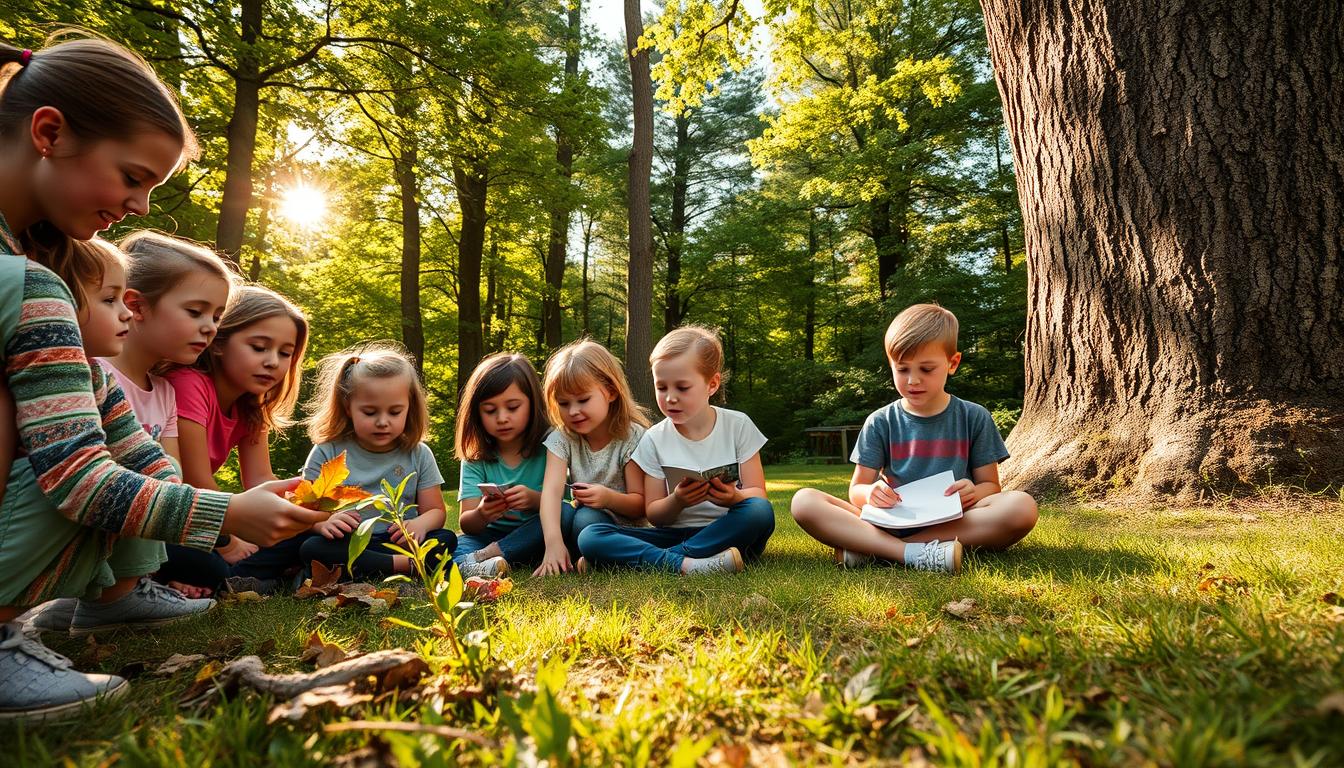Outdoor Learning Adventures for Young Children
Have you ever wondered how the natural world can become a classroom for your child? In today’s fast-paced world, traditional education often confines children to four walls. But what if we told you that stepping outside could unlock a world of creativity, curiosity, and growth?
Recent studies show that exploring nature helps children develop essential skills like observation, problem-solving, and critical thinking. It’s not just about fresh air—it’s about fostering a deeper connection with the environment while making education fun and engaging.
In this article, we’ll explore how outdoor adventures can enrich your child’s development. From scavenger hunts to journaling, these activities are designed to spark curiosity and build a lifelong love for the world around them. Let’s dive in and discover the endless possibilities!
Introduction: The Joy of Outdoor Learning Activities
Imagine a world where education feels like an adventure, not a chore. Stepping outside the traditional classroom opens doors to endless possibilities. It’s a space where children can explore, create, and grow in ways that textbooks alone cannot provide.
Outdoor settings nurture creativity and encourage a hands-on approach to education. Whether it’s observing plants, building structures, or solving problems, every moment becomes a lesson. This method not only makes education fun but also deeply engaging.
Research shows that spending time in nature improves physical health, emotional stability, and academic engagement. Children who play and learn outdoors are more active, focused, and curious. These benefits extend beyond the classroom, shaping well-rounded individuals.
Practical examples like outdoor classrooms and nature-based play have been successfully implemented in various educational settings. These approaches align with modern practices in India, emphasizing holistic development. By integrating regular outdoor engagement, we can foster a lifelong love for exploration and discovery.
Nature Scavenger Hunts: Exploring the Outdoors
Nature scavenger hunts are a fantastic way to blend fun and education. They encourage children to explore their surroundings while developing essential skills. These activities are not just about finding items; they’re about fostering curiosity and a deeper connection with the environment.
Scavenger hunts can be tailored to suit different age groups and skill levels. Whether it’s identifying leaves, spotting birds, or collecting natural treasures, each hunt offers a unique experience. Teachers and parents can use these activities to create engaging lessons that go beyond the classroom.
Planning Your Adventure: Tools and Tips
To get started, you’ll need a few simple tools. A basket or bag for collecting items, a magnifying glass for closer observation, and a journal for notes are essential. Creating a checklist of items to find, such as leaves, acorns, or feathers, helps guide the activity.
Safety is key. Always assess the area for potential risks and ensure proper supervision. Group collaboration can enhance the experience, but independent exploration also has its benefits.
Boosting Observation and Memory Skills
Scavenger hunts are excellent for improving observation and memory skills. Children learn to pay attention to details, such as colors, shapes, and textures. They also practice recalling information, like where they found specific items.
These activities encourage sensory exploration. For example, comparing the scents of different flowers or the textures of leaves can be both fun and educational. Seasonal changes, like tracking leaf colors in autumn, add another layer of learning.
| Tool | Purpose |
|---|---|
| Basket or Bag | Collecting natural items |
| Magnifying Glass | Observing details up close |
| Journal | Recording findings and notes |
| Checklist | Guiding the scavenger hunt |
Nature Journaling and Creative Outdoor Art Projects
What if a simple journal could transform how children see the world around them? Nature journaling is a powerful tool that combines creativity, observation, and skill development. It encourages children to explore their surroundings while fostering a deeper connection with the environment.
Inspiring Ideas for Effective Nature Journaling
Nature journaling is more than just writing—it’s about capturing the essence of the natural world. Here are some ideas to make it engaging and effective:
- Sketching Natural Elements: Encourage children to draw plants, animals, or landscapes they observe.
- Recording Sensory Details: Have them describe the sounds, smells, and textures they experience.
- Seasonal Observations: Track changes in the garden or local park, such as blooming flowers or falling leaves.
These techniques not only enhance creativity but also improve fine motor skills and attention to detail.
Transforming Natural Materials into Art
Nature provides endless inspiration for creative projects. Here are some fun and educational ideas:
- Leaf Rubbings: Use crayons and paper to capture the intricate textures of leaves.
- Rock Painting: Turn ordinary stones into colorful works of art.
- Ephemeral Art: Create temporary sculptures using flowers, twigs, and other natural items.
These projects bridge the gap between art and science, offering a multifaceted opportunity for growth. They also encourage children to appreciate the beauty and diversity of the natural world.
By integrating nature journaling and creative art into garden-based learning, we can create a holistic approach to education. These activities not only foster curiosity but also build a lifelong love for nature.
Bird Watching and Sensory Exploration in Natural Settings
What if a pair of binoculars could open up a world of discovery for your child? Bird watching is a rewarding practice that combines observation, patience, and a love for nature. It’s an excellent way to introduce children to the wonders of the natural world while enhancing their sensory exploration skills.
Getting Started with Bird Watching
Starting bird watching is simple and requires minimal tools. Here’s how to begin:
- Binoculars: Choose lightweight, child-friendly binoculars for clear viewing.
- Bird Guide: Use a guidebook or app to identify different bird species.
- Safe Spot: Find a quiet area with plenty of plants and trees to attract birds.
Setting up a bird feeder can also make this project more engaging. Use recycled materials like plastic bottles or egg cartons to create feeders. This not only benefits the birds but also teaches children about sustainability.
Engaging the Senses on a Nature Walk
Bird watching is just one part of sensory exploration. Nature walks can further enhance this experience. Encourage children to:
- Listen: Identify bird calls and other natural sounds.
- Observe: Notice the textures of leaves, bark, and feathers.
- Smell: Explore the scents of flowers and plants.
These activities not only boost observation skills but also foster a deeper connection with the environment. For more ideas on sensory play, check out this resource.
By making bird watching a regular project, we can instill a lasting interest in nature. It’s a practice that benefits children’s focus, patience, and understanding of wildlife. To explore more ways to integrate nature into education, visit this program.
Hands-on Outdoor Science Experiments
Science comes alive when children step outside and interact with the natural world. Hands-on experiments make scientific concepts tangible and exciting. They bridge the gap between theory and real-world application, fostering curiosity and critical thinking.
- Measuring Rainfall: Use a simple rain gauge to track precipitation over time. This activity teaches weather patterns and data collection.
- Tracking Shadows: Observe how shadows change throughout the day. This experiment demonstrates the sun’s movement and its effects.
- Water Filtration: Design a filtration system using sand, gravel, and charcoal. This project highlights environmental science and sustainability.
Tips for Setting Up Experiments
To create a successful outdoor classroom, consider these tips:
- Choose Safe Locations: Ensure the area is free from hazards and suitable for exploration.
- Use Simple Tools: Items like rulers, magnifying glasses, and journals enhance the experience without overwhelming children.
- Encourage Collaboration: Group activities promote teamwork and shared learning.
Teachers play a vital role in facilitating these experiments. They guide children, ensure safety, and help connect observations to scientific principles. By integrating these activities into the curriculum, we can create a dynamic and engaging learning environment.
Hands-on experiments in the natural world not only make science fun but also inspire a lifelong love for discovery. They encourage children to ask questions, seek answers, and appreciate the wonders of the world around them.
Integrating Outdoor Learning Activities into Daily Education
How can we make education more engaging by stepping beyond traditional classrooms? By transforming outdoor spaces into dynamic learning environments, we can create opportunities for students to explore, observe, and connect with the world around them. This approach not only enhances academic engagement but also fosters creativity and critical thinking.
Designing an Outdoor Classroom for Diverse Subjects
An outdoor classroom can be adapted to teach a wide range of subjects. For science, students can study plant growth or weather patterns. For art, natural materials like leaves and stones can inspire creative projects. Even math concepts, such as measuring distances or calculating areas, can be taught using the schoolyard as a living textbook.
Selecting the right materials is key. Items like chalkboards, seating, and storage for tools can make the space functional. Natural resources, such as trees, rocks, and water sources, add authenticity and encourage hands-on learning. These elements create an environment where students can thrive.
Tips for Teachers and Educators in India
In India, where resources and space can be limited, creativity is essential. Start small by using available areas like courtyards or gardens. Collaborate with local communities to gather materials and share ideas. For example, a simple garden can become a space for teaching biology and environmental science.
Consistency is crucial. Regular outdoor sessions help students connect theoretical knowledge with real-world experiences. Teachers can plan lessons that align with the curriculum while incorporating nature-based activities. This approach ensures that learning remains engaging and relevant.
Collaboration between teachers and parents can extend learning beyond the school. Encourage families to explore nature together, reinforcing lessons learned in class. This partnership strengthens the connection between education and the environment.
Successful examples of outdoor classrooms have shown improved academic outcomes and enhanced creativity among students. By integrating these practices, we can create a holistic educational experience that prepares students for the future. For more insights on innovative education methods, explore our online school education programs.
Outdoor Learning Activities for Holistic Child Development
What makes the great outdoors a perfect setting for holistic development? It’s a space where children can grow physically, emotionally, and intellectually. By blending play with structured outcomes, we create opportunities for curiosity and exploration to thrive.
Activities like scavenger hunts or nature journaling encourage children to observe and interact with their surroundings. These experiences not only support the curriculum but also foster a deeper connection with the environment. Every day becomes a chance to learn something new.
Combining Play with Educational Outcomes
Play is more than just fun—it’s a powerful tool for learning. When children engage in hands-on activities, they develop problem-solving skills and creativity. For example, a simple trip to the park can turn into a lesson about plants, animals, or even weather patterns.
Structured play also helps children meet academic goals. By integrating exploration into the curriculum, we make learning relevant and engaging. This approach ensures that children stay curious and motivated.
Partnering with Parents for Extended Learning
Parents play a crucial role in extending learning beyond the classroom. By encouraging outdoor activities at home, families can reinforce what children learn during the day. A visit to a local park or a family gardening project can spark meaningful conversations and discoveries.
Collaboration between educators and parents ensures that learning is consistent and holistic. Together, we can create a supportive environment where children thrive in the great outdoors.
Conclusion
Exploring nature unlocks a child’s potential in ways traditional methods cannot. It fosters curiosity, critical thinking, and a deeper connection with the world around them. By stepping outside, children develop the ability to observe, solve problems, and interact confidently.
These experiences are not just educational—they’re fun and transformative. They enhance academic growth while nurturing emotional and physical well-being. For educators and parents in India, embracing this approach can create a dynamic and engaging learning environment.
Let’s take the first step toward a brighter future. By integrating nature into daily education, we can inspire creativity, curiosity, and a lifelong love for exploration in every child.







